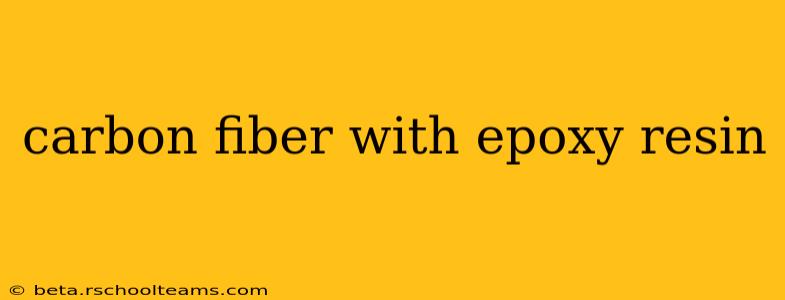Carbon fiber reinforced polymer (CFRP), commonly known as carbon fiber, is a remarkable material prized for its exceptional strength-to-weight ratio. When combined with epoxy resin, it forms a composite material with a wide array of applications, from aerospace components to high-performance sporting goods. This guide delves into the intricacies of this powerful pairing, exploring its properties, manufacturing processes, and common applications.
What is Carbon Fiber?
Carbon fiber is a material consisting of extremely thin, strong carbon filaments. These filaments are produced from organic polymers that undergo a process of carbonization at high temperatures, leaving behind almost pure carbon. This process results in fibers that are incredibly strong and lightweight, possessing a tensile strength exceeding that of steel.
What is Epoxy Resin?
Epoxy resin is a thermosetting polymer known for its exceptional adhesive properties, strength, and chemical resistance. It's a two-part system, typically consisting of a resin and a hardener. When mixed, a chemical reaction occurs, leading to curing and hardening of the mixture. This curing process results in a strong, durable, and chemically resistant material.
Why Combine Carbon Fiber and Epoxy Resin?
The synergy between carbon fiber and epoxy resin lies in their complementary properties. The carbon fiber provides the structural strength and stiffness, while the epoxy resin acts as a matrix, binding the fibers together and transferring loads between them. This combination results in a composite material that is significantly stronger and stiffer than either component alone, while retaining its lightweight nature.
How is Carbon Fiber Reinforced with Epoxy Resin?
The manufacturing process of CFRP involves several steps:
-
Fiber Layup: Carbon fiber sheets (prepreg) or individual tows are meticulously arranged according to a specific design to achieve the desired strength and stiffness in the final product.
-
Resin Infusion: The epoxy resin is then introduced into the fiber layup, either through vacuum bagging or autoclave molding. This ensures complete impregnation of the fibers, maximizing the bond strength.
-
Curing: The composite is then cured under controlled temperature and pressure. This process allows the epoxy resin to polymerize, resulting in a solid, high-strength material.
What are the Properties of Carbon Fiber with Epoxy Resin?
The resulting composite material boasts a remarkable combination of properties:
- High Strength-to-Weight Ratio: This is the defining characteristic of CFRP, making it ideal for applications where weight reduction is critical.
- High Stiffness: CFRP exhibits exceptional stiffness, resisting deformation under load.
- High Tensile Strength: It possesses outstanding tensile strength, allowing it to withstand significant pulling forces.
- Fatigue Resistance: CFRP demonstrates excellent resistance to fatigue failure, even under repeated stress.
- Chemical Resistance: Epoxy resin provides good resistance to many chemicals, enhancing the overall durability of the composite.
What are the Applications of Carbon Fiber with Epoxy Resin?
CFRP finds extensive use in various sectors:
- Aerospace: Aircraft components, spacecraft structures
- Automotive: High-performance vehicle parts, body panels
- Sporting Goods: Bicycle frames, golf clubs, tennis rackets
- Medical Devices: Prosthetic limbs, implants
- Wind Turbine Blades: Lightweight and strong blades for increased energy efficiency
What are the Advantages and Disadvantages of Using Carbon Fiber and Epoxy Resin?
Advantages:
- High strength-to-weight ratio
- High stiffness and rigidity
- Excellent fatigue resistance
- Good chemical resistance
- Design flexibility
Disadvantages:
- High cost
- Complex manufacturing processes
- Susceptibility to impact damage
- Difficult to repair
How Much Does Carbon Fiber with Epoxy Resin Cost?
The cost of carbon fiber reinforced with epoxy resin varies significantly based on factors such as the quantity, complexity of the part, and the type of manufacturing process employed. It's generally considered a high-cost material compared to traditional materials like steel or aluminum.
What are the Safety Precautions When Working with Carbon Fiber and Epoxy Resin?
Working with carbon fiber and epoxy resin requires appropriate safety precautions. These include:
- Respiratory Protection: Carbon fiber dust can irritate the lungs, necessitating the use of respirators.
- Skin Protection: Epoxy resin can cause skin irritation; gloves and protective clothing are crucial.
- Eye Protection: Safety glasses or goggles should be worn at all times.
- Ventilation: Adequate ventilation is necessary to prevent the buildup of volatile organic compounds.
This comprehensive overview provides a solid foundation in understanding carbon fiber with epoxy resin. Its unique combination of properties continues to drive innovation across numerous industries. Remember to always prioritize safety when working with these materials.
